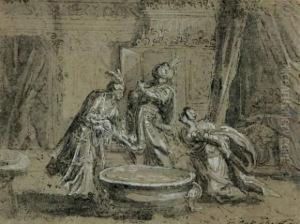Johann Andreas Thelott Paintings
Johann Andreas Thelott was a German artist born in 1655 in Augsburg, a city renowned for its artistic and craft traditions during the Holy Roman Empire. He was part of a family of engravers and artists, which included his father, Philipp Thelott the Elder, and his brothers, Philipp Thelott the Younger and Peter Thelott. The Thelott family worked in various artistic fields, including engraving, painting, and goldsmithing, indicating a versatile engagement with the arts typical of the period.
Johann Andreas Thelott is primarily recognized for his work as an engraver and illustrator. He received his artistic training likely within the family workshop, a common practice at the time, which allowed for the transmission of skills and techniques from one generation to the next. Thelott's works include a range of subjects, such as religious imagery, allegorical scenes, and decorative motifs, reflecting the diverse demands of art patrons during the Baroque period.
Throughout his career, Thelott contributed illustrations to books and produced independent engravings. His style was influenced by the Baroque sensibilities of the era, characterized by dramatic contrasts, intricate details, and a sense of movement. Engravings were a crucial medium for disseminating artworks and ideas across Europe, and Thelott's prints would have been collected and studied by artists and connoisseurs alike.
Johann Andreas Thelott's contributions to the arts were part of a larger cultural milieu in Augsburg, which was a hub for printmaking and publishing. His work not only reflects the artistic heritage of his family but also the broader context of the German Baroque tradition. Thelott continued to work and live in Augsburg until his death in 1734. His legacy is preserved through his surviving prints, which remain as a testament to the artistic skill and cultural vibrancy of his time.
